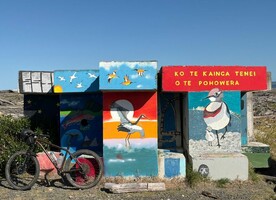News
Occupy the Red Zone
Posted 25 11 2016 by
in Magazine

Looking past bureaucratic obstacles, Bernd Gundermann proposes a future for Christchurch’s Red Zone that could serve as an archetype for riparian suburbs facing the e ects of climate-change.
Last time I was invited by Regenerate Christchurch to advise about the future of the Residential Red Zone along the Avon river, I emphasised that there is a realm beyond the frustration about both the ongoing ghts with hard-nosed insurers, and half a decade of stand-still in the physical recovery of the city.
It is within this rarely visited territory behind the spreadsheets and the “return on investment” clamour out of Wellington where the best solutions are found.
Christchurch’s Residential Red Zone by the river, bought by the Crown, momentarily is lost. Its dollar value is zero. However, its location between the larger part of the city and the seashore gives it a value when strategising responses to climate change. Utilised as green eco-buffer to counter the impact of sea-level rise, oods and storm surge its value will soar as the challenge unfolds.
But how to proceed with the land right now?
I believe the Red Zone can be restored, inhabited and work as an archetype for countless suburbs facing climate change. First, the zone should be completely reverse-engineered and free of environmentally harming remnants of human activity in order to avoid pollution when it eventually will go back to the sea. Hydrologists shall be asked about riverine erosion and sedimentation to sniff out safest places for homes. Ecologists will design a masterplan that connects the green dots that already exist in east Christchurch: Travis Wetlands, Bexley Park, South New Brighton Park, and the Residential Red Zone that becomes the Eastern Eco-sanctuary. The connections shall be
accomplished by greening the streets, making the pavements permeable, adding open drains and native trees; greening the metal roofs to stop pollution with heavy metals and reduce stress on the sewerage through rainfalls and oods.
Combined, these measures will not only change the appearance of the precincts, they will also replenish the biodiversity and the heightened birdsong will uplift the traumatised people.
The novelty of this masterplan will be its connection to complementary hydrological, seismic, and BIM-models that, constantly updated with scienti c data input, will determine when the scheduled exit- sequence will be due.
The currently demarcated Red Zone zigzags along the threshold within which liquefaction damaged the houses beyond repair. Its logic follows backward- looking scal and legal reasoning and is, therefore, irrelevant for moving forward. Science knows that potentially the entire Christchurch Plains are subject to liquefaction. Thus, I suggest that the Red Zone should be the testing ground for new prototypes of settlements in fragile, ood-prone land.
In my opinion, Christchurch should host an inter- national competition among interdisciplinary teams to design, build, and operate demountable stilt-hous- es that work off grid and take the US Department of Energy’s ”Solar Decathlon” to the next level. The brief should include passive house standards as well as renewable power sources besides solar. Additionally, smart interconnectivity to satellite-based warning
systems of oods, earthquakes, and extreme weath- er-events would make the houses feasible even in hazardous terrain such as coastal zones, where the majority of Kiwis live.
Working in the real landscape of Christchurch’s Red Zone and not in the arti cial environment of Wash- ington’s National Mall would make the prototypes realistic real-live-centred exemplars. Once their performance is optimised the new standards enter the Building Code and become Best Practice.
Tackling climate change in a creative hands-on way will leave behind the conventionalism of denial and help getting prepared without unnecessary anxiety.
An array of self-suf cient, pioneering communities, occupying the low-lying tidal marshlands may be not only the model for Christchurch’s future, in which green trumps grey and digital advancement amalgam- ates with ancient wisdom.
What a prospect, let’s get on with our future and occupy the Red Zone!
19 Dec
Christmas break 2025

see you from 12 January
As we wrap up another big year, we’re taking a moment to pause, breathe, and enjoy a well-earned break. Meri …
18 Dec
President’s update

December 2025
Earlier this month I attended the Ngā Aho Māori Design Professionals Wānanga-ā-Tau at Te Aranga Marae in Flaxmere. Tuia Pito …
18 Dec
Awards 2026 update

An update as we warm up for the 2026 Awards kaupapa. Submissions will open in March and will run for …
Events calendar
Full 2025 calendar